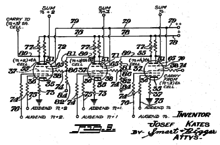
Summary
The Additron was an electron tube designed by Dr. Josef Kates, circa 1950, to replace the several individual electron tubes and support components required to perform the function of a single bit digital full adder. Dr. Kates developed the Additron with the intention of increasing the likelihood of success and reliability while reducing the size, power consumption and complexity of the University of Toronto Electronic Computer, (UTEC)[1]

The Additron neither went into production at the Canadian Rogers Vacuum Tube Company, where the prototypes were built, nor was it used in the UTEC machine. It did make a widely publicized appearance at the 1950 Canadian National Exhibition operating an electronic game of Tic-Tac-Toe, dubbed Bertie the Brain, to show the marvels of electronic computing.
The tube was registered with the Radio Television Manufacturing Association [2] on 20 March 1951 as type 6047.[3] [4] [5] [6]
Patents edit
- U.S. patent 2,784,312
References edit
- ^ Vardalas JN (2001). The Computer Revolution in Canada MIT Press, ISBN 0-262-22064-4
- ^ RTMA Engineering Department, Release #951, 20 March 1951
- ^ "6047 data sheet, RTMA Engineering Dept. Release #954" (PDF). Rogers Majestic Corp. March 20, 1951. Retrieved 14 August 2016.
- ^ Sibley L (2007). Weird Tube of the Month: The 6047 Tube Collector 9 (5):20
- ^ Osborne CS (2008).The Additron: A Binary Full Adder in a Tube Tube Collector 10 (4):12
- ^ "Binary Adder Tube for High-Speed Computers" (PDF). National Union Electric. September 1955. Retrieved 9 March 2021.


